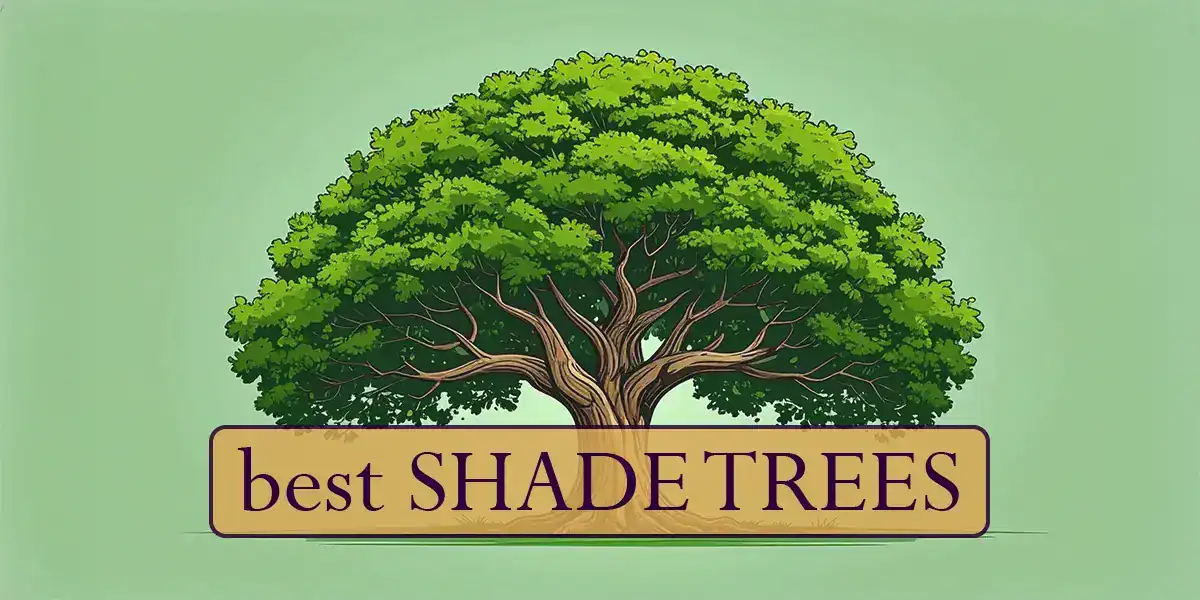Did you know that shade can extend the life of your driveway?
It’s true — shade can lower surface temperatures by 20°F to 45°F compared to areas exposed to direct sunlight. Air temperatures can drop by 5°F to 15°F under the canopy of a mature tree.
Shade shields your driveway from UV rays and heat expansion. It improves air quality by keeping soil cooler and reducing dust pollutants.
Shade also benefits plants in your garden and can significantly lower AC bills. So stop complaining about the heat and start planting shade trees!
7 Facts About Shade Trees
1. Shade trees actively cool the air.
Trees release water vapor from their leaves into the air. This draws heat energy from the surroundings and results in active cooling, much as sweating cools your skin. A large tree can transpire up to 100 gallons of water on a hot day!
2. Their root systems host microbial super-communities.
The root zones of shade trees are hotspots of beneficial microbial activity, including mycorrhizal fungi and nitrogen-fixing bacteria. These microorganisms help feed the tree while improving soil health, supporting nearby plants, and storing carbon.
3. Some shade trees have “self-mulching” habits.
Trees like live oaks and sweetgums shed small leaves or twigs year-round, forming a natural mulch layer that:
- Retains moisture
- Suppresses weeds
- Reduces soil temperature swings
This trait creates a self-sustaining microclimate around the tree.
4. Trees influence urban wind flow and noise.
- Well-placed shade trees can alter wind patterns and act as natural windbreaks.
- Dense canopies and foliage absorb and scatter sound waves, dampening noise pollution by 5 to 10 decibels.
5. Some shade trees can reorient their leaves.
Species like the redbud and honey locust can change the angle or position of their leaves during the day to optimize sunlight capture or reduce overheating.
6. Old shade trees are vital wildlife habitats.
Mature shade trees often develop cavities and hollows, which become nesting or roosting spots for birds, bats, owls, squirrels, and insects. One old oak tree may support up to 500 species in and around its structure.
7. Trees affect building longevity and energy use.
Trees planted near buildings can:
- Conserve energy use for cooling by 20–50%.
- Extend roof life by blocking UV exposure.
- Prevent foundation erosion by stabilizing soil.
Choosing the Right Shade Tree for Your Yard
Consider the following factors to pick the best tree for your space:
- Mature Size: Choose a tree based on its height and canopy spread when fully grown.
- Growth Rate: Need shade quickly? Look for fast growers. If you can wait, slower-growing trees often live longer.
- Care Needs: Some trees require lots of water, pruning, or fertilizing, while others are virtually maintenance-free.
- Special Features: Some trees have extra perks like drought tolerance, vibrant fall colors, or fragrant blossoms.
Let’s explore some of the best shade trees for LA’s toasty summers.
1. California Sycamore
- Mature Height: 40-100 feet
- Canopy Spread: 50-70 feet
- Growth Rate: Fast
- Expected Life: 150+ years
- Care Needs: Prefers deep watering during dry summers but tolerates drought once established.
- Special Features: Native to California, this species provides excellent shade and enhances wildlife habitat.
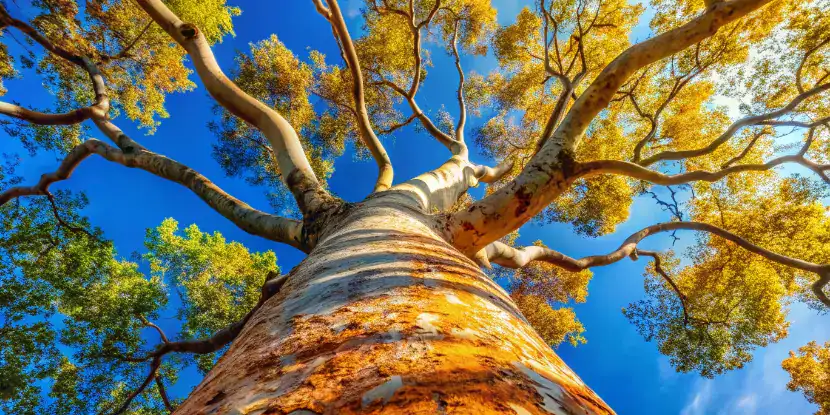
The magnificent trunk and clustered foliage of an old California sycamore tree.
2. Coast Live Oak
- Mature Height: 20-70 feet
- Canopy Spread: 40-70 feet
- Growth Rate: Moderate
- Expected Life: 150-250 years
- Care Needs: Thrives in well-drained soil and withstands drought.
- Special Features: Evergreen oak with dense foliage; great for native landscapes.
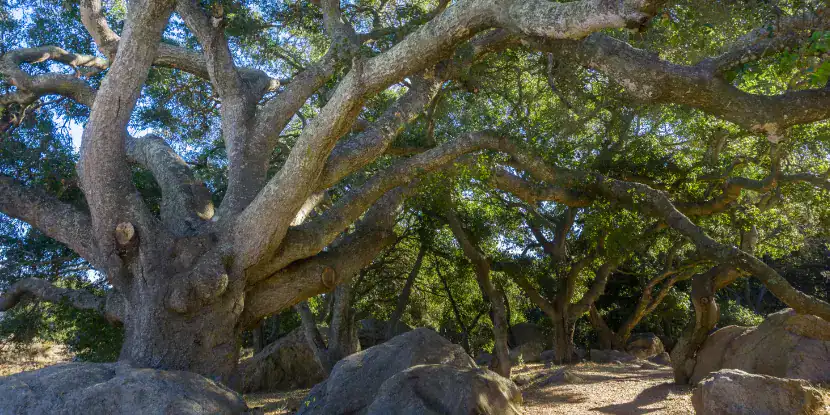
A coast live oak tree can live for 250 years. Stick around and watch it grow!
3. Jacaranda
- Mature Height: 25-50 feet
- Canopy Spread: 30-50 feet
- Growth Rate: Moderate to fast
- Expected Life: 50+ years
- Care Needs: Water deeply during the establishment phase; tolerates moderate drought.
- Special Features: Famous for its stunning purple blooms in spring and summer.
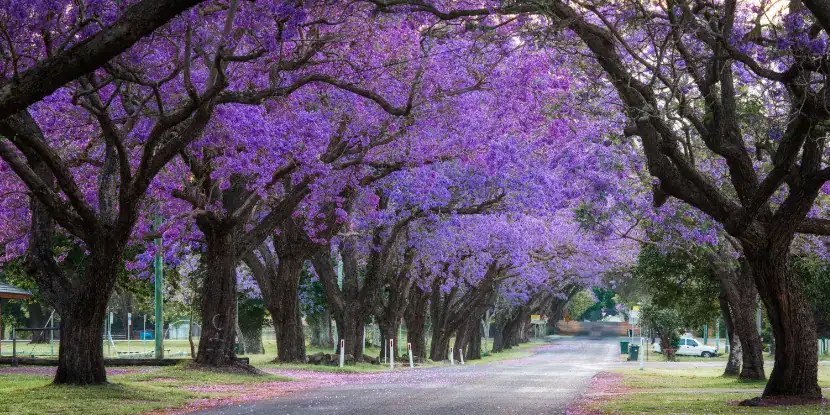
Jacaranda is a spectacular springtime tree as it explodes with purple blossoms.
4. Chinese Pistache
- Mature Height: 25-35 feet
- Canopy Spread: 25-35 feet
- Growth Rate: Moderate to fast
- Expected Life: 70-100 years
- Care Needs: Once established, very drought-tolerant and low-maintenance.
- Special Features: Show-stopping fall colors with fiery red and orange hues.
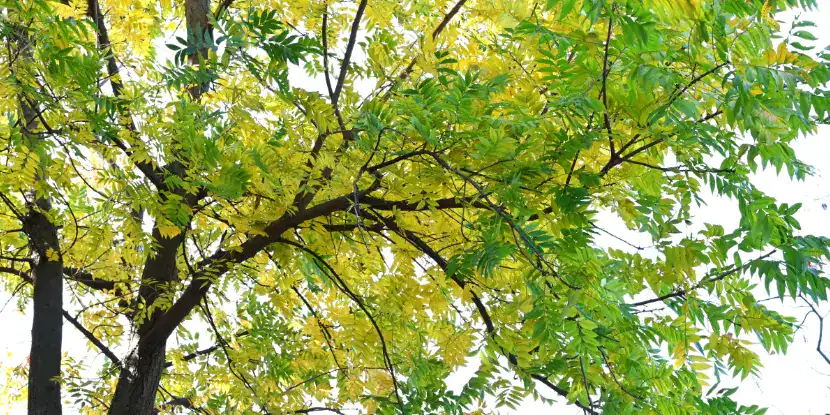
Once established, Chinese pistache is highly drought-tolerant and low-maintenance. It rewards you with fiery red and orange autumn colors.
5. Tipu Tree
- Mature Height: 25-50 feet
- Canopy Spread: 30-50 feet
- Growth Rate: Fast
- Expected Life: 50-150 years
- Care Needs: Requires pruning to maintain shape and occasional deep watering.
- Special Features: Beautiful golden-yellow flowers and a generous shade canopy.

Tipu offers beautiful golden-yellow flowers and a large shade canopy.
6. Southern Magnolia
- Mature Height: 60-80 feet
- Canopy Spread: 30-40 feet
- Growth Rate: Slow to moderate
- Expected Life: 80-120 years
- Care Needs: Requires regular watering and pruning in its early years.
- Special Features: Glossy green leaves and large, fragrant white flowers.
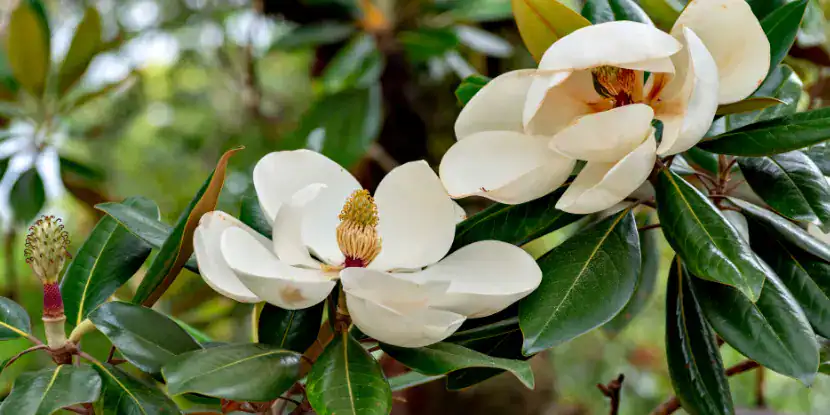
Magnolia trees bear showy white flowers that give way to distinctive seed pods.
7. Japanese Maple
- Mature Height: 15-25 feet
- Canopy Spread: 10-20 feet
- Growth Rate: Slow
- Expected Life: 80-100 years
- Care Needs: Requires well-drained soil and partial shade for optimal growth.
- Special Features: Delicate, colorful foliage and graceful branching.
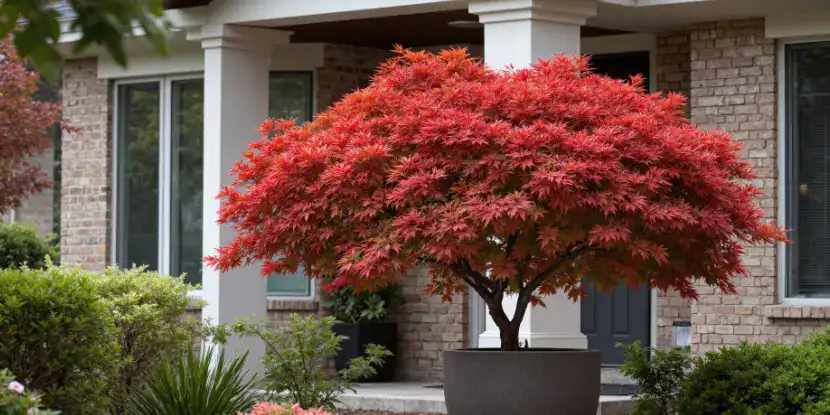
A potted Japanese maple with spectacular crimson foliage.
8. Bald Cypress
- Mature Height: 50-70 feet
- Canopy Spread: 20-30 feet
- Growth Rate: Moderate
- Expected Life: 600 years or more
- Care Needs: Prefers wet or swampy conditions but adapts to other soils.
- Special Features: Unique, feathery foliage that turns rusty orange in the fall.

This weathered bald cypress tree sports a toupee of wispy foliage.
9. Ginkgo
- Mature Height: 50-80 feet
- Canopy Spread: 30-40 feet
- Growth Rate: Slow
- Expected Life: Over 100 years
- Care Needs: Hardy and adaptable; prefers full sun and well-drained soil.
- Special Features: Unique fan-shaped leaves that turn bright yellow in the fall.
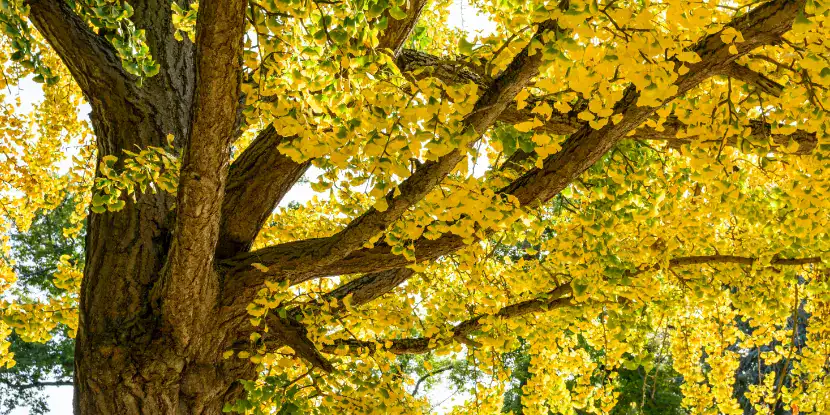
The ginkgo tree is a living fossil that predates the dinosaur.
10. Sweetgum
- Mature Height: 60-100 feet
- Canopy Spread: 40-60 feet
- Growth Rate: Moderate
- Expected Life: 150 years or more
- Care Needs: Prefers moist, acidic soil and full sun.
- Special Features: Star-shaped leaves and vibrant fall colors.
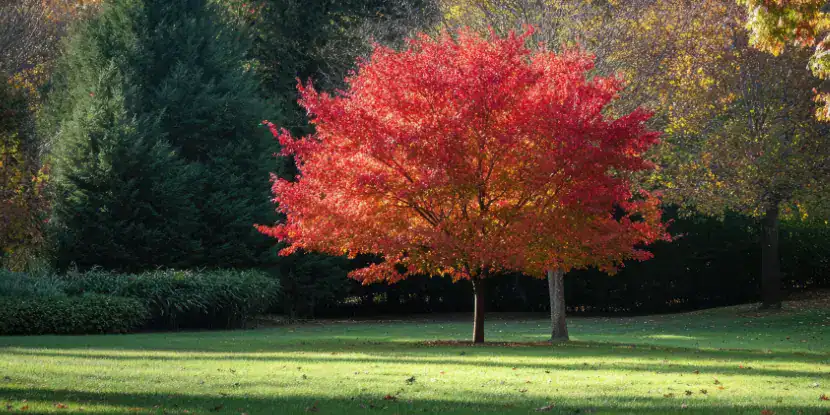
The sweetgum tree is known for its vibrant fall colors.
11. White Oak
- Mature Height: 50-80 feet
- Canopy Spread: 50-80 feet
- Growth Rate: Slow
- Expected Life: Over 300 years
- Care Needs: Requires well-drained soil and full sunlight.
- Special Features: Majestic canopy and long-lived, durable wood.
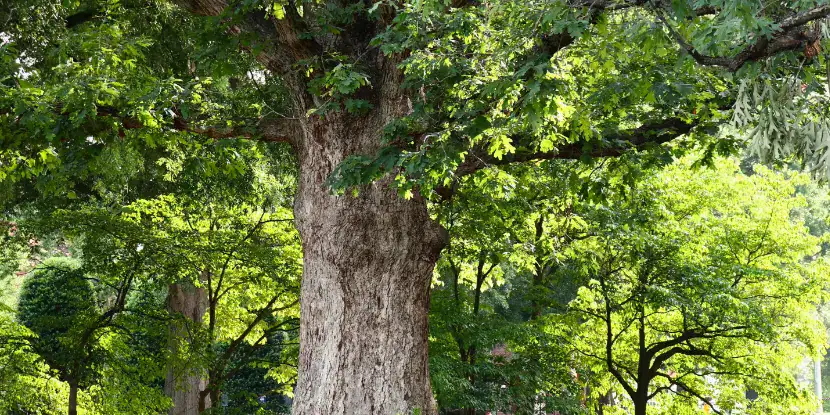
White oak can live over 300 years and develops a majestic spreading canopy.
12. Red Cedar
- Mature Height: 40-50 feet
- Canopy Spread: 8-20 feet
- Growth Rate: Moderate
- Expected Life: 100-300 years
- Care Needs: Tolerant of poor soils, drought, and extreme conditions.
- Special Features: Aromatic foliage and durable wood.
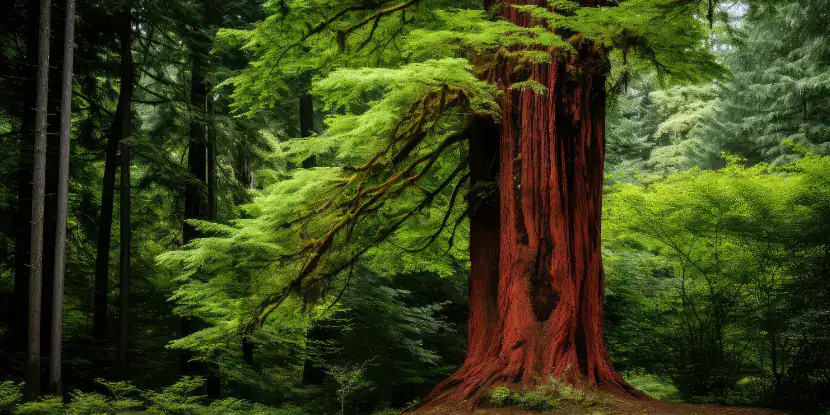
Guess how the red cedar got its name! This native tree tolerates poor soils, drought, and extreme conditions.
13. Black Walnut
- Mature Height: 50-75 feet
- Canopy Spread: 50-75 feet
- Growth Rate: Moderate
- Expected Life: Over 150 years
- Care Needs: Requires deep, fertile soil and ample space to thrive.
- Special Features: High-value lumber and edible nuts.

Black walnut trees provide ample shade and nuts for you and local wildlife. The squirrels will love you for planting one!
14. Weeping Willow
- Mature Height: 30-50 feet
- Canopy Spread: 30-40 feet
- Growth Rate: Fast
- Expected Life: 30-50 years
- Care Needs: Thrives near water but adaptable to other soil types with sufficient moisture.
- Special Features: Graceful, drooping branches create a striking silhouette.

The delicate draped foliage of a weeping willow tree.
15. Chinese Elm
- Mature Height: 40-60 feet
- Canopy Spread: 50-70 feet
- Growth Rate: Fast
- Expected Life: 50+ years
- Care Needs: Low-maintenance and drought-tolerant; prefers full sun and well-drained soils.
- Special Features: Graceful, arching branches and small, toothed leaves that create dense shade.
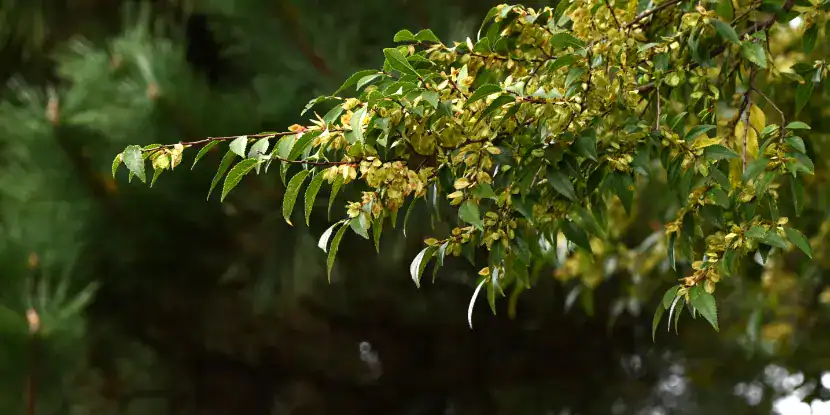
Chinese elm has graceful, arching branches and small, toothed leaves that create dense shade.
16. African Sumac
- Mature Height: 25-35 feet
- Canopy Spread: 25-35 feet
- Growth Rate: Moderate
- Expected Life: 50+ years
- Care Needs: Adapts to various soil types and is highly drought-tolerant once established.
- Special Features: Evergreen tree with a rounded canopy and distinctive reddish bark.

African sumac is an evergreen tree with long, spear-shaped leaves.
17. Palo Verde
- Mature Height: 15-30 feet
- Canopy Spread: 20-30 feet
- Growth Rate: Fast
- Expected Life: 50-150 years
- Care Needs: Flourishes in well-drained soils and requires minimal water once established; prefers full sun.
- Special Features: Striking green bark and vibrant yellow flowers make it a visually stunning drought-tolerant tree.
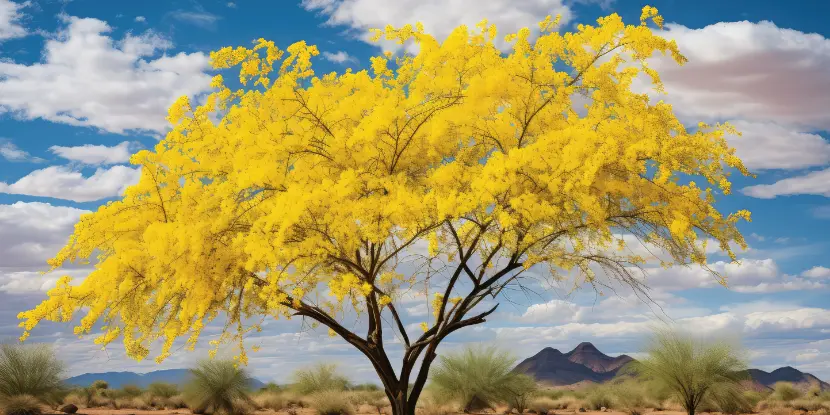
Palo Verde has a deep taproot that makes it ideal for xeriscapes.
When to Plant a Tree in LA
The best time to plant a tree in Southern California is late fall through early spring. In other words, avoid summer planting.
This period typically runs from November to March and coincides with the region’s rainy season.
Planting in cooler weather allows trees to acclimate gradually and establish strong root systems. It alleviates stress on newly planted trees, promotes healthier growth, and improves their chances of survival.
Pruning Your Shade Tree into Shape
Why Pruning is Essential
Pruning is crucial to tree maintenance, especially when shaping a tree’s canopy. Proper pruning:
- Encourages healthy growth by removing dead, diseased, or damaged branches.
- Improves air circulation and sunlight penetration throughout the canopy.
- Enhances structural integrity by shaping a well-balanced and stable canopy.
- Reduces the risk of falling branches, improving safety around the tree.
- Can dramatically improve the aesthetic and functionality of the tree, particularly for shade and ornamental purposes.
Best Time to Prune
The ideal time to prune most trees is during their dormant season, typically in late winter or early spring.
Pruning during dormancy is less stressful for the tree and reduces the risk of pest infestations or diseases entering pruning wounds.
However, you should remove hazardous or dead branches as soon as you notice them, no matter the season.
Always use sharp, clean tools like pruners, loppers, and tree saws.
Steps for Pruning
- Inspect the tree to identify dead, damaged, or diseased limbs that need removal. Also, consider the overall shape and decide which branches to trim to achieve the desired structure.
- Start by cutting away dead, broken, or diseased branches. This will improve the tree’s health and safety.
- Trim overcrowded branches to allow better light and air circulation. Focus on shaping the tree to have an open, balanced structure.
- Always cut just outside the branch collar (the swollen area at the branch’s base) to promote healing. Avoid cutting too close to the trunk or leaving stubs.
- Periodically step back to assess the shape and ensure the pruning aligns with the desired canopy structure.
FAQs: Shade Trees for LA
Q: How much water do shade trees typically need in Southern California?
This depends on the species, but many shade trees suitable for Los Angeles are drought-tolerant and require deep watering once a week during dry periods.
Q: How can I ensure my shade tree grows healthy and strong?
Proper planting, regular pruning, deep watering, and occasional soil amendments are key to maintaining a healthy shade tree.
Q: Do shade trees help reduce energy costs?
Strategically placed shade trees can significantly reduce cooling costs during hot summers by lowering ambient temperatures.
Q: Are there native shade trees that work well in Southern California?
Native options such as the Coast Live Oak and Western Redbud are well-adapted to the local ecosystem.
Q: What’s the best time to plant a shade tree in Southern California?
The ideal time is during fall or ear
ly spring when the weather is cooler, allowing roots to establish before the hotter months.
Q: How large do shade trees typically grow?
Size varies by species; some can grow up to 50–70 feet tall, while others, like smaller ornamentals, reach around 20 feet.
Q: Do shade trees require a lot of maintenance?
Drought-tolerant varieties require minimal care but may need regular pruning and pest and soil management.

